
Hosackia, Boutli., to which it approaches by the tendency to a piiiuato leaf, it differs by the approssod aim, tho
entire absence of stipules, aud tlie solitai-y llowers. De Candolle seems to have observed mouadolphous .
stamens in his specimens, hence he has been led to refer this plant to the gf>wxs Anthyllis ; but we find
the stamens to be truly diadelphous.
T ab. V III. Lotus subpinnatus. Fig. 1, Floiver; Jig. 2, Vexillum; Jig. 3, 3, Alte; Jig. 4, Carina; Jig. 5,
Side view of the carina; flg . 6, Stamens and pistil; Jig. 7, P istil; Jig. 8, Legumen; Jig'. 9, Leaf with
three terminal leaflets; Jig. 10, Leaf with only two terminal leaflets.
6. PSORALEA. L im .
1. P . glandulosa. L in n .—Bot. Mag. t. 900. D e Cand. Prodr. v. 2. p . 220.— Barba
Jovis, &c. vulgo Culen. Feuill. Chil. v. 3. p . 7. t. 3.
H ab. Conception.—This plant, according to Feuillee, is employed by the natives as a vulnerary and
purgative, and its dried leaves are ofteu used instead of tea.
7. ASTRAGALUS. DC.
1. A . procumbens ; ubique hirsuto-tomentosus, caule pro strato ramosissimo, stipulis
coucretis liberis, foliolis ll-1 4 -ju g Ìs ellipticis retusis, pedunculis folio longioribus racemosis,
alis c arina duplo brevìoribus, leguminibus (vix maturis) linearibus hirsutis reflexis.
Radix perennis, descendeos. Caules plurimi, procumbentes, diffusi, inferne fruticosi, bipedales et ultra,
teretes, moUiter tomentosi, valde ramosi. Folia digitalia, pinnata cum impari : foliolis tomentoso-hirsutis,
breviter petiolulatis, ellipticis, retusis, ll-l4-jugis. Stipules a petiolo liber®, ovat®, membranacea, inter se
hinc coalit®. Pedunculi axillares, folio duplo longiores, hirsuti, apice racemum hrevem gerentes. Flores
sparsi, pallide purpurei. Calyx tubulosos, 5-dentatus, dentibus setaceis. Carina obtusa, apice intense purpurea.
Alee carina duplo breiñores.
H ab. Conception.— This belongs to De Candolle’s tribe, Hypoglottidei, and is nearly allied to the A.
Garvancillo of Cavanilles ; nor is k far removed from A . unifultus of De Candolle. But those plants,
besides their differential characters, are natives of Peru.
2. A . prostratus ; diffusus, foliolis subpubescentibus obtusis, stipulis inter se et a petiolo
liberis, racemis pedunculatis folio multo longioribus, floribus laxiusculis subsessilibus
purpurascentibus, calyce higro-pubescente.
H ab. Conception.— This belongs to the section of Astragalus, “ D issitiflori” D C .; but on account
of the absence of fruit, and the paucity of specimens, we cannot give a satisfactory description. The
flowers are in rather long, spiked racemes, and somewhat drooping.
8. ADESMIA. DC.
1. A . papposa; caule herbáceo adscendente basi folioso et villoso, foliolis 8-10-jugis
obovatis retusis cum mucrone p arce pilosis, racemo terminali longissimo composito glabro
multifloro, floribus remotis, calyce eglanduloso.— De Cand. Prodr. v. 2. p . 319.
H ab. Conception.— With the fruit of this we are unacquainted, but if, as we believe, the plant is the same
as De Candolle’s A . papposa, it is covered with soft feathery set®. The species differs, however, from that
author’s character and description, in which the leaves are said to be ovali-lauceolate, and the flowers in a compact
raceme. The whole plant is free from glands, in which respect it is a t variance with what we conceive to
be A . longiseta of De Candolle, the only other known herbaceous species of the section, and of which we have
received beautiful specimens from Mr. Cruckshanks and Mr. Bridges. In both the alae are wrinkled transversely
a t the back, their claws are united with the base of the claw of the vexillum for nearly their whole